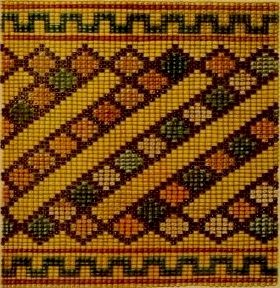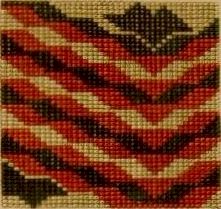|
|
While it is customary among many tribes of Indians to use as
little clothing as possible when engaged in dancing, either of a
social or ceremonial nature, the Ojibwa, on the contrary, vie with
one another in the attempt to appear in the most costly and gaudy
dress attainable. The Ojibwa Midē´
priests, take particular pride in their appearance when attending
ceremonies of the Midē´ Society, and seldom fail to impress this
fact upon visitors, as some of the Dakotan tribes, who have adopted
similar medicine ceremonies after the custom of their Algonkian
neighbors, are frequently without any clothing other than the
breechcloth and moccasins, and the armlets and other attractive
ornaments. This disregard of dress appears, to the Ojibwa, as a
sacrilegious digression from the ancient usages, and it frequently
excites severe comment.
Apart from facial ornamentation, of such design as may take the
actor’s fancy, or in accordance with the degree of which the subject
may be a member, the Midē´ priests wear shirts, trousers, and
moccasins, the first two of which may consist of flannel or cloth
and be either plain or ornamented with beads, while the latter are
always of buckskin, or, what is more highly prized, moose skin,
beaded or worked with colored porcupine quills.
| Immediately below each knee is tied a necessary item of
an Ojibwa’s dress, a garter, which consists of a band of
beads varying in different specimens from 2 to 4 inches in
width, and from 18 to 20 inches in length, to each end of
which strands of colored wool yarn, 2 feet long, are
attached so as to admit of being passed around the leg and
tied in a bow-knot in front. These garters are made by the
women in such patterns as they may be able to design or
elaborate. On Pl. XXIII are reproductions of parts of two
patterns which are of more than |

Plate XXIII. Midē´ Dancing Garters. |
 |
| ordinary interest, because of the symbolic
signification of the colors and the primitive art design in
one, and the substitution of colors and the introduction of
modern designs in the other. The upper one consists of
green, red, and white beads, the first two colors being in
accord with those of one of the degree posts, while the
white is symbolical of the mī´gis
shell. In the lower illustration is found a substitution of
color for the preceding, accounted for by the Midē´
informants, who explained that neither of the varieties of
beads of the particular color desired could be obtained when
wanted. The yellow beads are substituted for white, the blue
for green, and the orange and pink for red. The design
retains the lozenge form, though in a different arrangement,
and the introduction of the blue border is adapted after
patterns observed among their white neighbors. In the former
is presented also what the Ojibwa term the groundwork or
type of their original style of ornamentation, i.e., wavy or
gently zigzag lines. Later art work consists chiefly of
curved lines, and this has gradually become modified through
instruction from the Catholic sisters at various early
mission establishments until now, when there has been
brought about a common system of working upon cloth or
velvet, in patterns, consisting of vines, leaves, and
flowers, often exceedingly attractive though not aboriginal
in the true sense of the word. |
Bands of flannel or buckskin, handsomely beaded, are sometimes
attached to the sides of the pantaloons, in imitation of an
officer’s stripes, and around the bottom. Collars are also used, in
addition to necklaces of claws, shells, or other objects.
Armlets and bracelets are sometimes made of bands of beadwork,
though brass wire or pieces of metal are preferred.
Bags made of cloth, beautifully ornamented or entirely covered with
beads, are worn, supported at the side by means of a broad band or
baldric passing over the opposite shoulder. The head is decorated
with disks of metal and tufts of colored horse hair or moose hair
and with eagle feathers to designate the particular exploits
performed by the wearer.
Few emblems of personal valor or exploits are now worn, as many of
the representatives of the present generation have never been
actively engaged in war, so that there is generally found only among
the older members the practice of wearing upon the head eagle
feathers bearing indications of significant markings or cuttings. A
feather which has been split from the tip toward the middle denotes
that the wearer was wounded by an arrow. A red spot as large as a
silver dime painted upon a feather shows the wearer to have been
wounded by a bullet. The privilege of wearing a feather tipped with
red flannel or horse hair dyed red is recognized only when the
wearer has killed an enemy, and when a great number have been killed
in war the so-called war bonnet is worn, and may consist of a number
of feathers exceeding the number of persons killed, the idea to be
expressed being “a great number,” rather than a specific
enumeration.
Although the Ojibwa admit that in former times they had many other
specific ways of indicating various kinds of personal exploits, they
now have little opportunity of gaining such distinction, and
consequently the practice has fallen into desuetude.
This site includes some historical
materials that may imply negative stereotypes reflecting the culture or language
of a particular period or place. These items are presented as part of the
historical record and should not be interpreted to mean that the WebMasters in
any way endorse the stereotypes implied. The Midē Wiwin or Grand Medicine Society, 1891
The Midē Wiwin or Grand Medicine Society
 |

